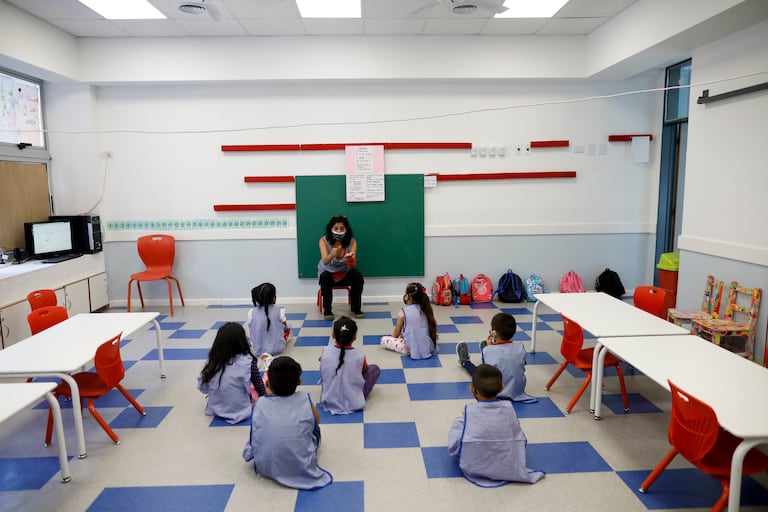A teacher with her five-year-old students on the first day of the 2021 school year, in Buenos Aires.Natacha Pisarenko / AP
This Monday, the schools of the city of Buenos Aires reopened their doors to students after being closed for almost a year due to the covid-19 pandemic.
Some students were excited to be reunited with their classmates and others nervous to return to classrooms after a 2020 in which they had to deal with virtual platforms from home.
First thing in the morning, mothers and fathers helped their children with their backpacks and reminded them that they had to keep their masks on at all times.
Many found it difficult to wait their turn to enter, but others did not want to let go of the hand of the person who accompanied them to the door.
The school buildings are the same, but everything else has changed: their temperature is taken at the entrance and alcohol gel is placed on them.
They cannot hug or hold on when playing.
They are divided by bubbles.
Hours have been shortened.
“This is the first time that my son has wanted to go to school.
Is happy.
Last year was very difficult for everyone.
He didn't want to connect to the
zooms
and he drove me crazy all day while I tried to telecommute, ”says Graciela, mother of an eight-year-old boy who this year starts third grade in a public school in the Buenos Aires neighborhood of Villa Ortúzar.
“I am afraid that it will be infected, but I think they need to return because at home they learn almost nothing.
It depends a lot on each family, in some cases they had to connect with their parents' cell phone ”, he adds.
As in most double-day schools, each class here has been subdivided into two groups, one going for three hours in the morning and another three in the afternoon.
For now, the dining room service continues to be suspended and the scholarship families receive a bag with food to cook at home.
In single-day schools, students attend two days one week and three the next.
Better three hours than none.
But let's hope that vaccination advances quickly, that teachers and older adults are vaccinated and we can regain normalcy, ”says José Manuel, father of a second-grade boy who wears a mask with the image of Ironman, his favorite superhero.
At his side, another father doubts that this will happen before 2022 and predicts that in the fall there will be a regrowth that will force the classrooms to close again.
The return is made in a staggered manner.
In Buenos Aires today it has been the turn of 370,493 students of early childhood education, the first three grades of primary school, the two initial grades of secondary and special modality.
On-site classes have also returned in the provinces of Santa Fe, Jujuy and Santiago del Estero.
Next week will be the first day for the rest of the students in the Argentine capital and other provinces will also join.
The province of Buenos Aires, the most populated in the country, will start on March 1.
If the planned schedule is met, by the middle of next month almost all of Argentina's 11.5 million school-age children and adolescents will be back in the classroom.
Presence is mandatory except for those who belong to a risk group or live with someone who is in the same situation.
Those students will be taught remotely.
“It is something expected by everyone, a careful return to the complexity that we continue to experience.
It is a different school from the prepandemic one, which has to apply the protocols ”, the Argentine Minister of Education, Nicolás Trotta, said in radio statements.
Educational gap
The emergence of the covid-19 pandemic in Argentina in early March 2020 led the Government of Alberto Fernández to suspend face-to-face classes less than 15 days after the start of the school year.
As in other countries, education became virtual, but the educational gap in a country with a very large territory and more than 40% of its population in poverty was soon evident.
Less than half of the households have good quality fixed Internet access and one in two do not have a computer available for educational purposes.
According to official data, around one million students enrolled in 2020 had little or no contact with their school.
The government broadcast educational content on public radio and television and published educational notebooks, but in the second half of the year there was increasing pressure for education to become face-to-face again.
Still, classrooms were only partially reopened in some provinces and temporarily.
"The learning that could not be achieved in 2020 will be addressed in 2021, understanding both school years as a pedagogical unit allowing the intensification of teaching, the curricular reorganization and the accreditation of said temporary unit," said the educational authorities last Friday .
When leaving the schools, it was possible to see students with happy faces for the return and others who complained about the new prohibitions, the fact that some friends had been in another bubble and the reduction of recess time.
Among adults, on the other hand, relief at having regained a certain normality predominated.
This was the case of Teresa, a designer and mother of two twin daughters aged seven and one aged ten: “I can't imagine another year with them all day at home.
I hope the protocols work and the face-to-face classes are not interrupted ”.
Subscribe here
to the
EL PAÍS América
newsletter
and receive all the informative keys of the region's current affairs

